A Metamaterial-Based Double-Sided Bowtie Antenna for Intelligent Transport System Communications Operating in Public Safety Band
Abstract
1. Introduction
- Fulfilling consumer needs enabled by 5G,
- Providing next-generation Wi-Fi connectivity
- Ensuring reliable communication for V2X under IoV.
2. Antenna Design
Parametric Study of the Antenna Design
3. Result and Discussion
4. Conclusions
Author Contributions
Funding
Data Availability Statement
Acknowledgments
Conflicts of Interest
References
- Calabuig, D.; Martín-Sacristán, D.; Monserrat, J.F.; Botsov, M.; Gozálvez, D. Distribution of road hazard warning messages to distant vehicles in intelligent transport systems. IEEE Trans. Intell. Transp. Syst. 2017, 19, 1152–1165. [Google Scholar] [CrossRef]
- Kannappan, L.; Palaniswamy, S.K.; Wang, L.; Kanagasabai, M.; Kumar, S.; Alsath, M.G.N.; Rao, T.R. Quad-port multiservice diversity antenna for automotive applications. Sensors 2021, 21, 8238. [Google Scholar] [CrossRef] [PubMed]
- Syedakbar, S.; Subramaniam, R.; Vijay, R. Orthogonally integrated hybrid antenna for intelligent transportation systems. Appl. Compust. Electromagn. Soc. J. 2021, 36, 519–525. [Google Scholar]
- Kishore, N.; Upadhyay, G.; Prakash, A.; Tripathi, V.S. Millimeter wave antenna for Intelligent transportation systems application. J. Microw. Optoelectron. Electromagn. Appl. 2018, 17, 171–178. [Google Scholar] [CrossRef]
- Singh, P.; Chaitanya, K.S.R.; Kumari, R. Microstrip patch antenna for application in intelligent transport systems. In Proceedings of the 2019 TEQIP III Sponsored International Conference on Microwave Integrated Circuits, Photonics and Wireless Networks (IMICPW), Tiruchirappalli, India, 22–24 May 2019. [Google Scholar]
- Pallavi, M.; Kumar, P.; Ali, T.; Shenoy, S.B. Modeling of a Negative Refractive Index Metamaterial Unit-Cell and Array for Aircraft Surveillance Applications. IEEE Access 2022, 10, 99790–99812. [Google Scholar] [CrossRef]
- Zabri, S.N.; Mohd Salleh, N.; Abu, M.; Mohamad, S.Y. Study of a flexible antenna for intelligent transport system application. In Proceedings of the 2017 IEEE Asia Pacific Microwave Conference (APMC), Kuala Lumpur, Malaysia, 13–16 November 2017; pp. 1357–1360. [Google Scholar]
- Mondal, T.; Maity, S.; Ghatak, R.; Chaudhuri, S.R.B. Compact circularly polarized wide-beamwidth fern-fractal-shaped microstrip antenna for vehicular communication. IEEE Trans. Veh. Technol. 2018, 67, 5126–5134. [Google Scholar] [CrossRef]
- Nagalapur, K.K.; Strom, E.G.; Brannstrom, F.; Carlsson, J.; Karlsson, K. Robust Connectivity With Multiple Directional Antennas for Vehicular Communications. IEEE Trans. Intell. Transp. Syst. 2019, 21, 5305–5315. [Google Scholar] [CrossRef]
- Wen, L.; Gao, S.; Luo, Q.; Hu, W.; Yin, Y. Wideband dual circularly polarized antenna for intelligent transport systems. IEEE Trans. Veh. Technol. 2020, 69, 5193–5202. [Google Scholar] [CrossRef]
- Yamamoto, K.; Ohno, K.; Itami, M. A study on space division DS/SS Inter-Vehicle Communication system using circular array antenna. In Proceedings of the 2009 9th International Conference on Intelligent Transport Systems Telecommunications, (ITST), Lille, France, 20–22 October 2009; pp. 91–96. [Google Scholar]
- Mondal, T.; Ghatak, R.; Chaudhuri, S.B. Design and analysis of a 5.88 GHz microstrip phased array antenna for intelligent transport systems. In Proceedings of the 2010 IEEE Antennas and Propagation Society International Symposium, Toronto, ON, Canada, 11–17 July 2010. [Google Scholar]
- Abbas, T.; Karedal, J.; Tufvesson, F. Measurement-Based Analysis: The Effect of Complementary Antennas and Diversity on Vehicle-to-Vehicle Communication. IEEE Antennas Wirel. Propag. Lett. 2013, 12, 309–312. [Google Scholar] [CrossRef]
- Maddio, S. A compact circularly polarized antenna for 5.8-GHz intelligent transportation system. IEEE Antennas Wirel. Propag. Lett. 2016, 16, 533–536. [Google Scholar] [CrossRef]
- Sharma, N.; Kumar, A.; Arya, A.K. Design of reconfigurable compact dual polarized antenna for multiband operation. In Proceedings of the 2017 International Conference on Computer, Communications and Electronics (Comptelix), Jaipur, India, 1–2 July 2017. [Google Scholar]
- Kishore, N.; Prakash, A.; Tripathi, V.S. A multiband microstrip patch antenna with defected ground structure for its applications. Microw. Opt. Technol. Lett. 2016, 58, 2814–2818. [Google Scholar] [CrossRef]
- Althuwayb, A.A.; Al-Hasan, M.J.; Kumar, A.; Chaturvedi, D. Design of half-mode substrate integrated cavity inspired dual-band antenna. Int. J. RF Microw. Comput. Aided Eng. 2021, 31, e22520. [Google Scholar] [CrossRef]
- Kumar, A.; Chaturvedi, D.; Raghavan, S. Dual-band, dual-fed self-diplexing antenna. In Proceedings of the 2019 13th European Conference on Antennas and Propagation (EuCAP), Krakow, Poland, 31 March–5 April 2019; pp. 1–5. [Google Scholar]
- Karasawa, K.; Toda, R.; Yamaguchi, R.; Ashida, K.; Karakama, T.; Kaneko, T. 700MHz band Planar Antenna for Inter-vehicle Communication System and Mobile Phone. In Proceedings of the 2020 IEEE 9th Global Conference on Consumer Electronics (GCCE), Kobe, Japan, 13–16 October 2020; pp. 861–864. [Google Scholar]
- Khan, M.; Rizwan, F.; Kim, S. On the Feasibility of 4.9 GHz Public Safety Band as Spectrum Option for Internet of Vehicles. In Proceedings of the 2022 International Conference on Electronics, Information, and Communication (ICEIC), Jeju, Republic of Korea, 6–9 February 2022. [Google Scholar]
- Lalbakhsh, A.; Simorangkir, R.B.; Bayat-Makou, N.; Kishk, A.A.; Esselle, K.P. Advancements and artificial intelligence approaches in antennas for environmental sensing. In Artificial Intelligence and Data Science in Environmental Sensing; Elsevier: Amsterdam, The Netherlands, 2022; pp. 19–38. [Google Scholar]
- Lalbakhsh, A.; Afzal, M.U.; Esselle, K.P.; Smith, S.L. All-Metal Wideband Frequency-Selective Surface Bandpass Filter for TE and TM Polarizations. IEEE Trans. Antennas Propag. 2022, 70, 2790–2800. [Google Scholar] [CrossRef]
- Norouzi, M.; Jarchi, S.; Ghaffari-Miab, M.; Esfandiari, M.; Lalbakhsh, A.; Koziel, S.; Reisenfeld, S.; Moloudian, G. 3D metamaterial ultra-wideband absorber for curved surface. Sci. Rep. 2023, 13, 1043. [Google Scholar] [CrossRef]
- Kamal, B.; Ali, U.; Chen, J.; Ullah, S. Applications of Metamaterials and Meta Surfaces; IntechOpen: London, UK, 2022. [Google Scholar]
- Kumar, R.; Kumar, M.; Chohan, J.S.; Kumar, S. Overview on metamaterial: History, types and applications. Mater. Today Proc. 2022, 56, 3016–3024. [Google Scholar] [CrossRef]
- Esfandiyari, M.; Lalbakhsh, A.; Jarchi, S.; Ghaffari-Miab, M.; Mahtaj, H.N.; Simorangkir, R.B. Tunable terahertz filter/antenna-sensor using graphene-based metamaterials. Mater. Des. 2022, 220, 110855. [Google Scholar] [CrossRef]
- Das, P.; Mandal, K.; Lalbakhsh, A. Beam-steering of microstrip antenna using single-layer FSS based phase-shifting surface. Int. J. RF Microw. Comput.-Aided Eng. 2022, 32, e23033. [Google Scholar] [CrossRef]
- Lalbakhsh, A.; Afzal, M.U.; Hayat, T.; Esselle, K.P.; Mandal, K. All-metal wideband metasurface for near-field transformation of medium-to-high gain electromagnetic sources. Sci. Rep. 2021, 11, 9421. [Google Scholar] [CrossRef] [PubMed]
- Das, P.; Mandal, K.; Lalbakhsh, A. Single-layer polarization-insensitive frequency selective surface for beam reconfigurability of monopole antennas. J. Electromagn. Waves Appl. 2020, 34, 86–102. [Google Scholar] [CrossRef]
- Paul, G.S.; Mandal, K.; Lalbakhsh, A. Single-layer ultra-wide stop-band frequency selective surface using interconnected square rings. AEU Int. J. Electron. Commun. 2021, 132, 153630. [Google Scholar] [CrossRef]
- Vallappil, A.K.; Khawaja, B.A.; Rahim, M.K.A.; Iqbal, M.N.; Chattha, H.T.; Ali, M.F.M. A compact triple-band UWB inverted triangular antenna with dual-notch band characteristics using SSRR metamaterial structure for use in next-generation wireless systems. Fractal Fract. 2022, 6, 422. [Google Scholar] [CrossRef]
- Paragya, D.; Siswono, H. 3.5 GHz Rectangular Patch Microstrip Antenna with Defected Ground Structure for 5G. ELKOMIKA J. Tek. Energi Elektr. Tek. Telekomun. Tek. Elektronika 2020, 8, 31. [Google Scholar] [CrossRef]
- Vallappil, A.K.; Rahim, M.K.A.; Khawaja, B.A.; Iqbal, M.N. Compact Metamaterial Based 4 × 4 Butler Matrix with Improved Bandwidth for 5G Applications. IEEE Access 2020, 8, 13573–13583. [Google Scholar] [CrossRef]
- Rammoorthyraju, K.; Prasanna Kumar, P. Design of CPW-fed dual-folded slot patch antenna for 4.9 GHz public safety spectrum. In Proceedings of the International Conference on Information Communication and Embedded Systems (ICICES2014), Chennai, India, 27–28 February 2014; pp. 1–5. [Google Scholar]
- Vallappil, A.K.; Rahim, M.K.A.; Khawaja, B.A.; Iqbal, M.N.; Murad, N.A.; Gajibo, M.M.; Nur, L.O.; Nugroho, B.S. Complementary split-ring resonator and strip-gap based metamaterial fractal antenna with miniature size and enhanced bandwidth for 5G applications. J. Electromagn. Waves Appl. 2021, 36, 787–803. [Google Scholar] [CrossRef]
- Wang, W.; Wu, Y.; Wang, W.; Yang, Y. Isolation Enhancement in Dual-Band Monopole Antenna for 5G Applications. IEEE Trans. Circuits Syst. II Express Briefs 2020, 68, 1867–1871. [Google Scholar] [CrossRef]
- Ren, Z.; Zhao, A. Dual-band MIMO antenna with compact self-decoupled antenna pairs for 5G mobile applications. IEEE Access 2019, 7, 82288–82296. [Google Scholar] [CrossRef]
- Vinodha, E.; Raghavan, S. Double stub microstrip fed two element Rectangular Dielectric Resonator Antenna for multiband operation. AEU Int. J. Electron. Commun. 2017, 78, 46–53. [Google Scholar] [CrossRef]
- Kohli, S.; Dhillon, S.S.; Marwaha, A. Design and optimization of multiband fractal microstrip patch antenna for wireless applications. In Proceedings of the 2013 5th International Conference and Computational Intelligence and Communication Networks, Mathura, India, 27–29 September 2013; pp. 32–36. [Google Scholar]
- Kumar, A.; Chaturvedi, D.; Raghavan, S. Low-profile substrate integrated waveguide (SIW) cavity-backed self-triplexed slot antenna. Int. J. RF Microw. Comput. Aided Eng. 2019, 29, e21606. [Google Scholar] [CrossRef]
- Ucar, M.H.B.; Erdemli, Y.E. Triple-band microstripline-fed printed wide-slot antenna for WiMAX/WLAN operations. Appl. Comput. Electromagn. Soc. J. 2014, 29, 793–800. [Google Scholar]
- Naji, D.K. Miniature Slotted Semi-Circular Dual-Band Antenna for WiMAX and WLAN Applications. J. Electromagn. Eng. Sci. 2020, 20, 115–124. [Google Scholar] [CrossRef]


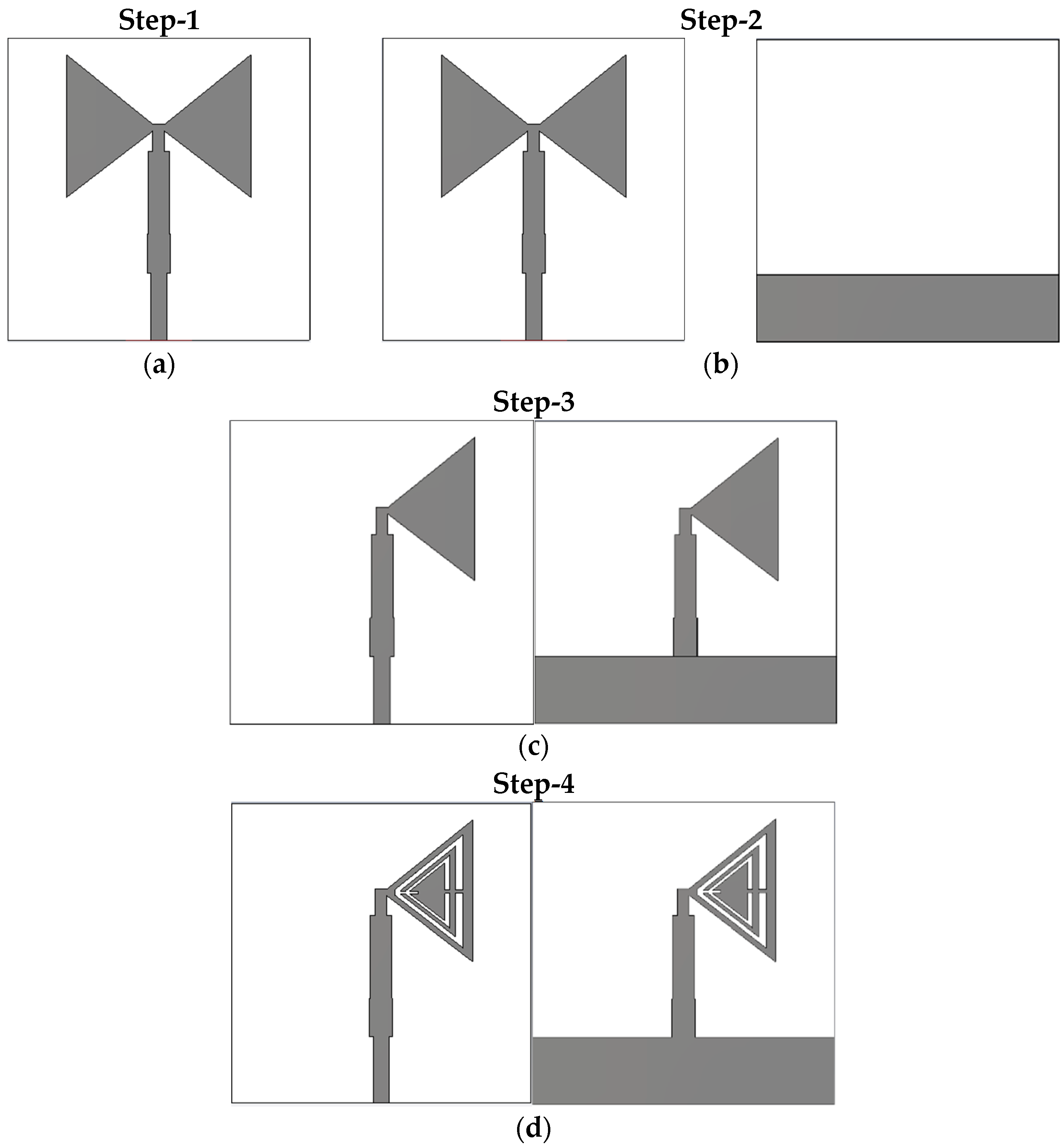
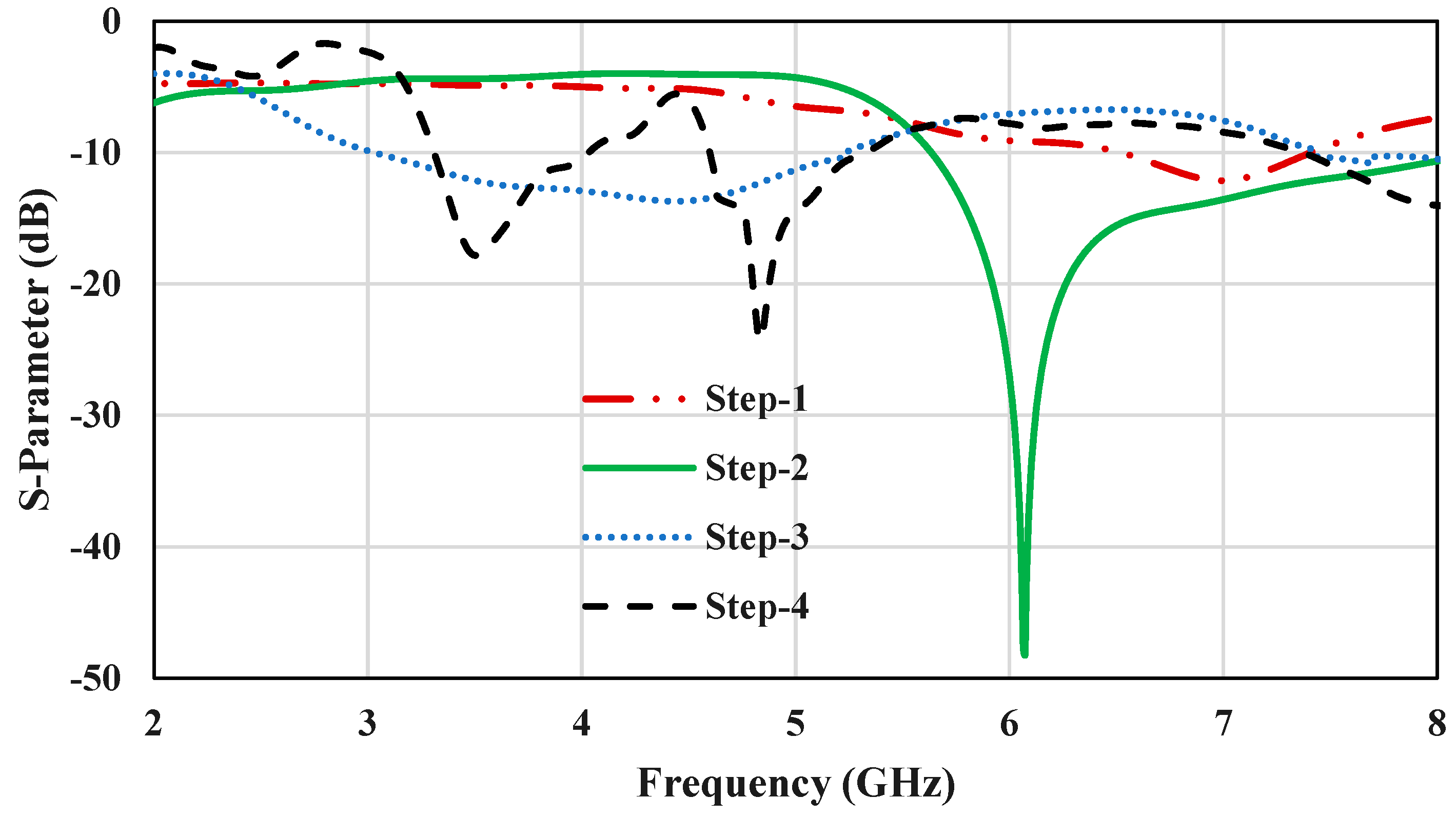
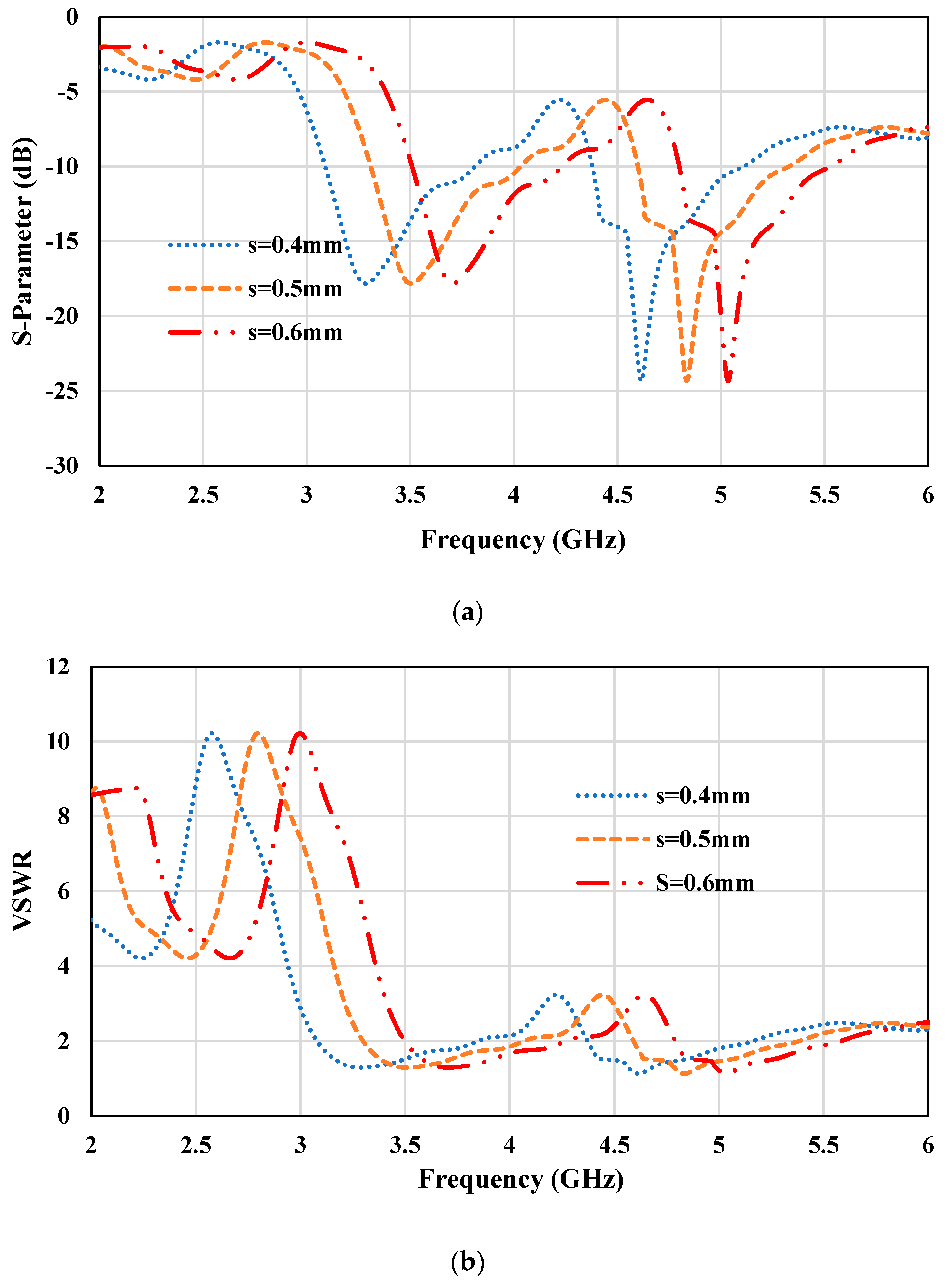


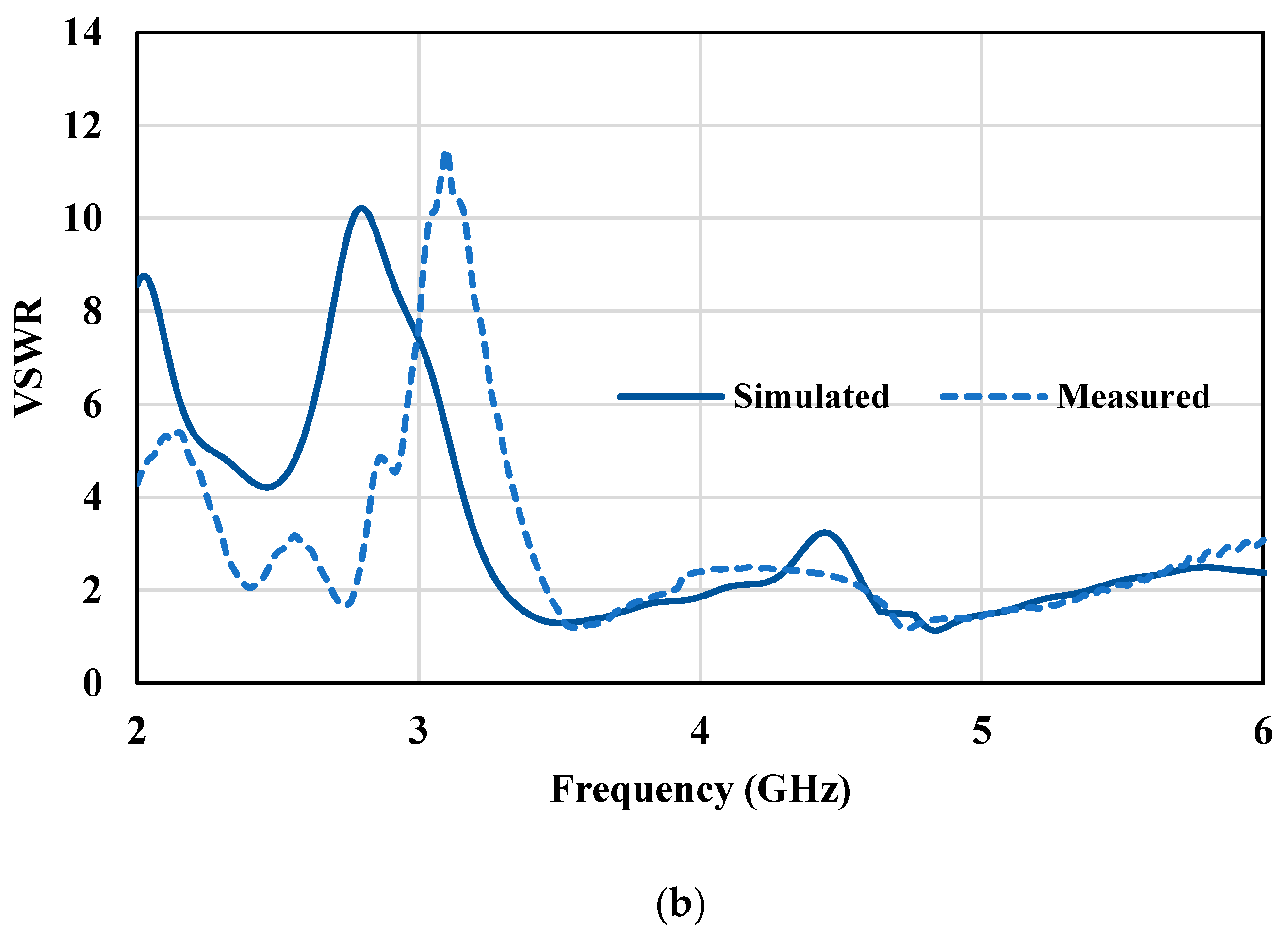
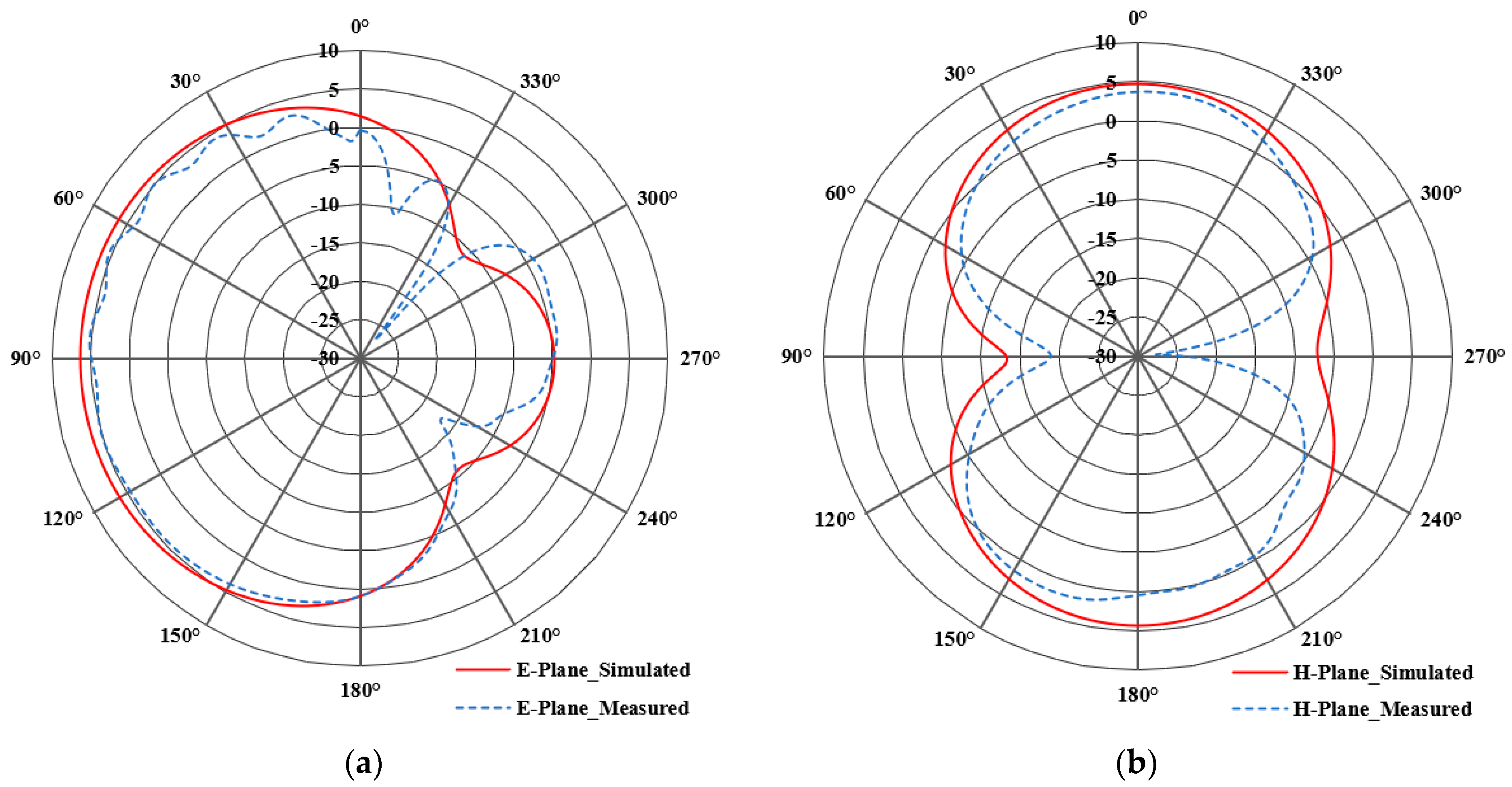


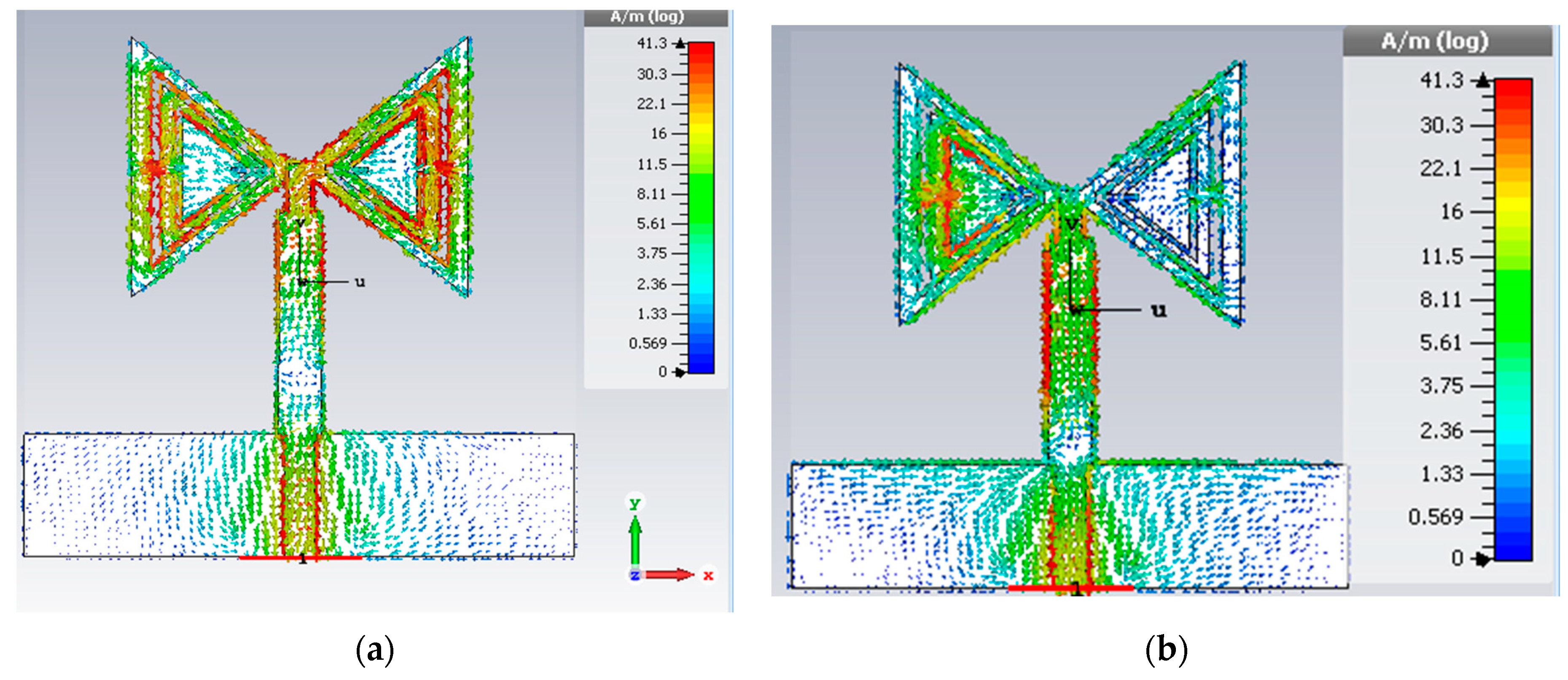

| Parameter | Dimension (mm) | Parameter | Dimension (mm) |
|---|---|---|---|
| L | 36 | Lg | 6 |
| L1 | 6 | W | 36 |
| L2 | 16.5 | W1 | 8.7 |
| L3 | 3.2 | t1 | 0.75 |
| L4 | 15 | t2 | 0.6 |
| L5 | 11.82 | s | 0.5 |
| L6 | 9.46 | ||
| L7 | 12 |
| s (mm) | Operating Band | Rejection Band |
|---|---|---|
| 0.4 | 3.1–3.8/4.4–5.31 | 3.8–4.4 |
| 0.5 | 3.3–4/4.6–5.3 | 4–4.6 |
| 0.6 | 3.5–4.2/4.8–5.5 | 4.2–4.8 |
| Ref. | Dimension (mm) | εr | Operating Frequency (GHz) | Bandwidth (%) | Gain (dBi) | Efficiency (%) | No. of Layers |
|---|---|---|---|---|---|---|---|
| [34] | 0.18λo × 0.24λo × 0.013λo | 4.3 | 4.9 | 3.6 | 4 | 98 | Single |
| [35] | 0.33λo × 0.34λo × 0.018λo | 4.3 | 3.5 | 10.5 | 2.42 | - | Single |
| [36] | 0.54λo × 0.45λo × 0.017λo | 3.55 | 3.5/4.8 | 5.7/4 | 2.45/4.56 | - | Single |
| [37] | 1.76λo × 0.88λo × 0.009λo | 4.3 | 3.5/4.9 | 5.7/4 | 6/8 | 70/70 | Single |
| [38] | 0.79λo × 0.79λo × 0.025λo | 4.3 | 4.76/5.86/9.2 | 2/12/18.2 | 6.35/5.57/3.9 | 82/85/91 | Single |
| [39] | 0.6λo × 0.6λo × 0.041λo | 2.2 | 4.7/6.5/7.7/8.5 | 3.19/2.07/6.75/14.11 | 5.45/5.42/7.05/5.64 | - | Single |
| [40] | 0.67λo × 0.65λo × 0.04λo | 2.2 | 5.57/7.17/7.65 | - | 4.1/3.95/3.54 | 60/50/65 | Single |
| [41] | 0.75 λo × 0.75λo × 0.016λo | 2.2 | 2.6/3.5/5.5 | 36/17/9 | 6/6.7/7 | 97/95/94 | Single |
| [42] | 0.2λo × 0.21λo × 0.009λo | 4.4 | 3.5/5.8 | 8.5/2.5 | 1.83/137 | 94/79 | Single |
| This work | 0.4λo × 0.4λo × 0.018λo | 4.3 | 3.5/4.9 | 12/16 | 5.64/4 | 89/73 | Single |
Disclaimer/Publisher’s Note: The statements, opinions and data contained in all publications are solely those of the individual author(s) and contributor(s) and not of MDPI and/or the editor(s). MDPI and/or the editor(s) disclaim responsibility for any injury to people or property resulting from any ideas, methods, instructions or products referred to in the content. |
© 2023 by the authors. Licensee MDPI, Basel, Switzerland. This article is an open access article distributed under the terms and conditions of the Creative Commons Attribution (CC BY) license (https://creativecommons.org/licenses/by/4.0/).
Share and Cite
Alsisi, R.H.; Karimbu Vallappil, A.; Wajid, H.A. A Metamaterial-Based Double-Sided Bowtie Antenna for Intelligent Transport System Communications Operating in Public Safety Band. Crystals 2023, 13, 360. https://doi.org/10.3390/cryst13020360
Alsisi RH, Karimbu Vallappil A, Wajid HA. A Metamaterial-Based Double-Sided Bowtie Antenna for Intelligent Transport System Communications Operating in Public Safety Band. Crystals. 2023; 13(2):360. https://doi.org/10.3390/cryst13020360
Chicago/Turabian StyleAlsisi, Rayan Hamza, Arshad Karimbu Vallappil, and Hafiz Abdul Wajid. 2023. "A Metamaterial-Based Double-Sided Bowtie Antenna for Intelligent Transport System Communications Operating in Public Safety Band" Crystals 13, no. 2: 360. https://doi.org/10.3390/cryst13020360
APA StyleAlsisi, R. H., Karimbu Vallappil, A., & Wajid, H. A. (2023). A Metamaterial-Based Double-Sided Bowtie Antenna for Intelligent Transport System Communications Operating in Public Safety Band. Crystals, 13(2), 360. https://doi.org/10.3390/cryst13020360






